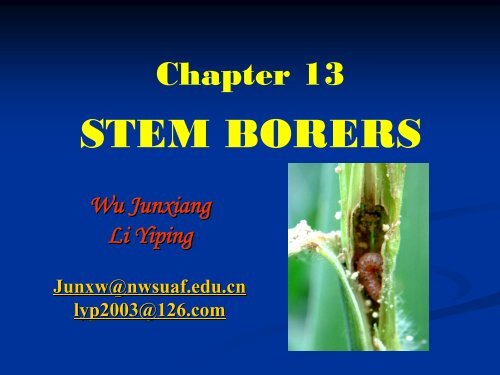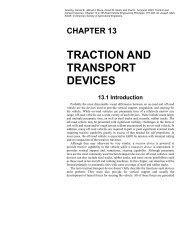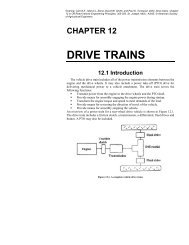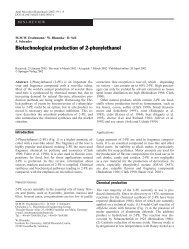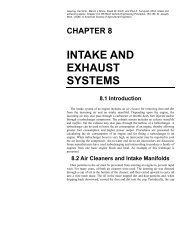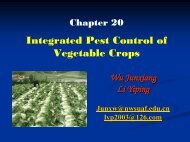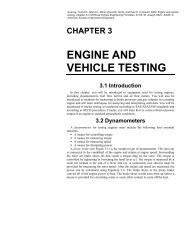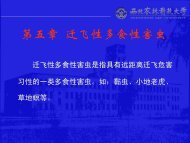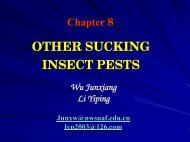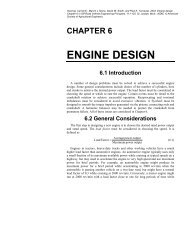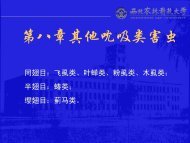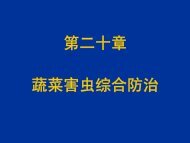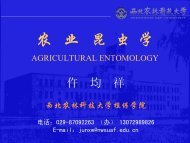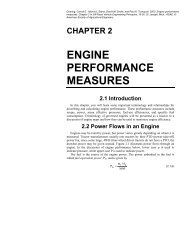STEM BORERS
STEM BORERS
STEM BORERS
Create successful ePaper yourself
Turn your PDF publications into a flip-book with our unique Google optimized e-Paper software.
Chapter 13<br />
<strong>STEM</strong> <strong>BORERS</strong><br />
Wu Junxiang<br />
Li Yiping<br />
Junxw@nwsuaf.edu.cn<br />
lyp2003@126.com
Chapter 13 <strong>STEM</strong> <strong>BORERS</strong><br />
Lecture Outline<br />
‣ Corn borers<br />
‣ Rice borers<br />
‣ Other stem borers<br />
‣ Monitoring and Management
Corn Borers<br />
Chinese byname is 玉 米 钻 心 虫 or 箭 杆 虫 ,<br />
belong to Lepidoptera, Pyralidae. 2 species<br />
recorded in China:<br />
• Asian corn borer Ostrinia furnacalis<br />
• Europe corn borer O. nubilalis<br />
Asian corn borer is predominant in China.
1. Distribution<br />
• Asian corn borer: Asia and Oceania;<br />
Nationwide distribution in China;<br />
• Europe corn borer: Europe, Northwestern<br />
Africa, Western Asia and Northern America;<br />
Predominant species in Yili, Xinjiang;<br />
• Occasionally found in Ningxia, Inner<br />
Mongolia and Hebei, but Asian corn borer is<br />
more predominant
2. Damage<br />
Polyphagous pests, more than 200 host<br />
plants recorded.<br />
Mainly cause damage through boring<br />
plants as larvae. During seedling stage of corn<br />
or sorghum, bore leaves to produce “ 花 叶 ”.<br />
During seedling stage of millet, bore young<br />
leaves to produce “ 枯 心 ”. After rice shooting<br />
and heading stages, larval damage influences<br />
nutrient transportation in plants, causing<br />
plants to produce non-rich grains. Also, larval<br />
damaged plants are easily pushed down by<br />
strong winds.
3. Life Cycle<br />
1-6 generations/year in China. 2-3 in<br />
Northeast and mid-downstream of Yellow<br />
River; 3-4 in mid-downstream of Yangtsz<br />
River; 5-6 in Huanan area.<br />
Overwinter as grown larvae in stems, ear<br />
centers and root stubbles of corns.
3. Behavior<br />
Adults:<br />
Activity at night; hide in crops or weeds<br />
during daytime;<br />
Good at flying with phototaxis;<br />
Eggs laid at back of leaves near central<br />
veins in masses of scales; 20-30 eggs a<br />
mass and 300-600 eggs per female adult;<br />
Prefer not to lay on plants lower than<br />
50cm.
Larvae<br />
‣ Newly hatched larvae crawl quickly to<br />
spread out or spin silk to move to other<br />
plants;<br />
‣ Prefer sugar and moisture, but don’t like<br />
light;<br />
3. Behavior
3. Behavior<br />
Larvae<br />
‣During the late seedling period, newly<br />
hatched larvae feed on the mesophyll of<br />
young un-spread leaves or bore into curled<br />
young leaves to produce consecutive spots or<br />
holes when the leaves are unfurled. The<br />
situation of consecutive holes, caused by the<br />
insects boring through un-spread leaves’<br />
layers is often called “ 花 叶 或 链 珠 孔 ”.<br />
在 玉 米 心 叶 期 , 初 孵 幼 虫 取 食 未 展 开 的 心 叶 叶 肉 , 或 将 纵 卷 的 心 叶<br />
蛀 穿 , 到 心 叶 伸 展 后 , 叶 面 呈 现 半 透 明 斑 点 , 孔 洞 呈 横 列 排 孔 , 通 称<br />
“ 花 叶 或 链 珠 孔 ”。
3. Behavior<br />
Before the male flower appears, most<br />
larvae either bore into the stems of male<br />
flowers to break the male flowers, or bore<br />
into plant stems above female ears.<br />
在 雄 穗 出 现 前 , 幼 虫 大 多 蛀 入 雄 穗 柄 内 , 造 成 折 雄 , 或 蛀 入 雌<br />
穗 以 上 节 内 。
3. Behavior<br />
During the female ear period, most younger larvae<br />
in male flowers bore into the stem at its points of<br />
connection with female ears and into its upper and<br />
lower stem segments. This damage severely<br />
influences plant nutrient transportation and<br />
female ear growth, even causing stems to break. A<br />
stem break below the female ears can cause a<br />
severe reduction of plant harvest.<br />
玉 米 抽 丝 时 , 原 在 雄 穗 上 一 些 较 小 的 幼 虫 , 大 多 自 雌 穗 节 及 上 下<br />
茎 节 蛀 入 , 严 重 破 坏 养 分 输 送 和 影 响 雌 穗 的 发 育 , 甚 至 遇 风 造 成 折 茎<br />
而 减 产 , 尤 以 穗 下 折 茎 影 响 产 量 最 重 。
3. Factors influencing population<br />
1) Climate conditions<br />
‣ Prefer middle temperatures and high humidity;<br />
optimal temp.15-30℃ and RH +60%;<br />
‣ Precipitation and humidity would influence the<br />
overwintered larvae to pupate, adults to oviposit<br />
and eggs to hatch. At the same time, also influence<br />
the parasitoid wasp’s population.<br />
‣ facultative diapause insect
3. Factors influencing population<br />
2) Culture<br />
Prefer summer sowing to spring sowing;<br />
avoid mixture of both sowing seasons.<br />
3) Natural enemy<br />
Over 70 predators and parasitoids found<br />
in China, such as pine caterpillar<br />
trichogrammatids, corn borer<br />
trichogrammatids and white<br />
muscardine fungi.
3. Factors influencing population<br />
4) Host plants<br />
Adults prefer to choose plants sown early, that are<br />
growing well, with very green leaves to oviposit;<br />
Variety resistance: Corn contains certain<br />
substances, called anti-borertin ( 抗 螟 素 ), resistant to<br />
insects. These include: anti-borertins A, B and C. Of<br />
which, anti-borertin A and anti-borertin C, called<br />
“Dimboa”, are the most effective in resistance.
Rice Stalk Borers<br />
• Striped rice borer, Asian rice borer<br />
Chilo suppressalis ( 二 化 螟 )<br />
• Tryporyza incertulas ( 三 化 螟 )<br />
Lepidoptera, Pyralidae
Striped rice borer<br />
Asian rice borer<br />
Chilo suppressalis<br />
( 二 化 螟 )
Striped rice borer, Asian rice borer<br />
Chilo suppressalis ( 二 化 螟 )
Tryporyza incertulas ( 三 化 螟 )
1. Distribution<br />
Chilo suppressalis: Continents of both Asia<br />
and Europe and all the countries of Southeast<br />
Asia; Nationwide distribution in China;<br />
Tryporyza incertulas: Tropical to subtropical<br />
areas of Asia; The valley of Yangtse<br />
River and southern areas in China, most<br />
severe damage found in plains along seas and<br />
rivers.
2. Damage<br />
Chilo suppressalis is polyphagous; rice,<br />
wheat, corn, sorghum, water bamboo ( 茭 白 ),<br />
sugarcane, millet, horsebean ( 蚕 豆 ), etc;<br />
Tryporyza incertulas is monophagous;<br />
rice and wild rice;
2. Damage<br />
Newly hatched larvae aggregate, burrow into leaf<br />
sheathes, and cause leaf sheathes to become dry ( 枯<br />
鞘 ). Larvae at and/or beyond their second instar do<br />
different damage at different plant stages. During<br />
the tillering stage, they burrow into stems and cause<br />
the seedlings to dry up or die ( 枯 心 苗 ); during the<br />
booting stage, the bootings to die ( 死 孕 穗 ); during<br />
the heading stage, heads to become white ( 白 穗 );<br />
during the mature stage, the plants to be damaged<br />
( 虫 伤 株 ).
2. Damage<br />
枯 心 团<br />
白 穗<br />
Rice borer damage
3. Life Cycle<br />
1) Chilo suppressalis ( 二 化 螟 )<br />
1-5 generations a year; 2 in the region<br />
from 32° to 36°N latitude. (Southern<br />
Shaanxi, Henan, Anhui, Hubei); 3-4 between<br />
26° and 32°N latitude. (valley of Yangtse<br />
River); 5 south of 20°N latitude. (islands of<br />
Hainan) .
3. Life Cycle<br />
Overwinter as 4 th to 6 th instar larvae in rice<br />
stakes ( 稻 桩 ), straws ( 稻 草 ), water bamboo ( 茭 白 )<br />
and other places around paddy fields.<br />
Overwintered nonmature larvae (4 th or 5 th instar)<br />
come out to feed on wheat, horsebean and rape.
3. Life Cycle<br />
2. Tryporyza incertulas ( 三 化 螟 )<br />
2-7 generations/year; 3-4 in middownstream<br />
paddy areas of Yangtse River;<br />
4-7 in areas south of Yangtse River.<br />
Overwinter as grown larvae in rice stems.<br />
Overwintered larvae pupate and emerge<br />
as weather becomes warm (over 16℃)
4. Behavior<br />
Adults:<br />
• Fallow during daytime and active at night;<br />
• Strong phototaxis;<br />
• Prefer ovipositing eggs on<br />
green and healthy plants;<br />
• Eggs laid in masses on faces<br />
of leaves
4. Behavior<br />
Larvae:<br />
• Newly hatched larvae crawl along rice leaves down<br />
or spin to spread; intrude rice stems from sheath<br />
gaps ( 叶 鞘 ).<br />
• Tryporyza incertulas Larvae prefer white tissue of,<br />
and rarely feed on, green parts of sheathes. After<br />
burrowing into a stem, they eat the vascular<br />
bundles at the horizontal level they entered at,<br />
leaving the sheath and stem outerside ( 断 环 ), and<br />
then eat upward. Each individual larva follows this<br />
same eating pattern upon entering a new plant.
5. Relationship with environment<br />
1) Climate conditions<br />
Chilo suppressalis favors lower temp.; most<br />
found in hill and mountain areas. Tryporyza<br />
incertulas prefers warm conditions, causes severe<br />
damage in plain rice areas.
5. Relationship with environment<br />
2) Culture<br />
Rice borers occur more severely in mixed paddy<br />
areas consisting of single cropping rice ( 单 季 稻 ) and<br />
double cropping rice ( 双 季 稻 ) due to more consistent<br />
rice growth periods. Generally, young larval<br />
hatching periods do not coincide well with rice<br />
growths suited for larval intruder, but in areas of<br />
single cropping rice or double cropping rice<br />
continuous planting, there is a longer period of rice<br />
growth suitable for rice borer’s intrusion.
5. Relationship with environment<br />
3) Natural enemies<br />
Egg parasitoid wasps are most important.<br />
Maximum parasite rate is 80-90%.<br />
4) Host plants<br />
Cross rice is more suitable to growth and<br />
development than common rice.<br />
Rice is the only host of Tryporyza<br />
incertulas.
Other Stem Borers<br />
( 其 它 蛀 茎 害 虫 )
1. Common Species<br />
• Meromyza saltatrix ( 麦 秆 蝇 )<br />
• Melanagromyza sojae( 豆 秆 黑 潜 蝇 )<br />
• Chilo venosatus ( 高 梁 条 螟 )<br />
• Chilo infuscatellus ( 粟 灰 螟 )<br />
• Sesamia inferens ( 大 螟 )<br />
• Apophylia flavoviens ( 玉 米 旋 心 虫 )<br />
• Chlorops oryzae ( 稻 秆 蝇 )<br />
• Ceuthorrhynchus asper ( 油 菜 茎 象 甲 )<br />
• Janus pire ( 梨 茎 蜂 )
2. Meromyza saltatrix ( 麦 秆 蝇 )<br />
‣ Called also 麦 钻 心 虫 or 麦 蝇 ;<br />
‣ Diptera, Chloropidae ( 黄 潜 蝇 科 );<br />
‣ Distributed in northern spring wheat areas<br />
and winter wheat areas of Huabei Plain;<br />
‣ Host plants include wheat, barley and rye<br />
( 黑 麦 );<br />
‣ Newly hatched larvae intrude stem from<br />
sheath, feed down in a twisting motion and<br />
cause seedlings to die ( 枯 心 ), ears become<br />
white ( 白 穗 ) or rot ( 烂 穗 ).
3-44 generations/year in<br />
winter wheat areas;<br />
Overwinter as larvae in<br />
wheat seedling or weeds;<br />
Larvae of overwintered<br />
and 1st generation damage<br />
wheat;<br />
Most severe damage<br />
caused from April to May.
3. Melanagromyza sojae ( 豆 秆 黑 潜 蝇 )<br />
‣ Called also 豆 秆 蝇 , 豆 秆 穿<br />
心 虫 or 豆 秆 蛇 潜 蝇 ;<br />
‣Diptera,<br />
‣Agromyzidae ( 潜 蝇 科 );<br />
‣Distributed in soybean<br />
planting area of valleys<br />
of Yellow River and<br />
Huai River.
3. Melanagromyza sojae ( 豆 秆 黑 潜 蝇 )<br />
4-13 generations a year;<br />
Overwinter as pupa in root stubbles and<br />
stalks;<br />
Eggs laid under epidemics of lead-back<br />
near main vein on the mid-lower parts of<br />
plants;<br />
Main control measures include destroying<br />
overwinter hosts and spraying insecticides<br />
when and after adults emerge.
4. Chilo infuscatellus ( 粟 灰 螟 )<br />
Chinese byname is 谷 子 钻 心 虫 or 二 点 螟 ;<br />
Lepidoptera, Pyralidae;<br />
Distributed in most provinces in China;<br />
Prefers feeding on millet; also often feeds<br />
on corn and sorghum but does not cause as<br />
much damage to these plants;
4. Chilo infuscatellus ( 粟 灰 螟 )<br />
Larvae burrow into and feed on stem<br />
bases, causing seedlings to become dry<br />
and/or die. Also, this basis damage makes it<br />
easy for strong winds to push the seedlings<br />
down. If a seedling is pushed down, it makes<br />
it unlikely that it will grow well and offer a<br />
good harvest.
3. Melanagromyza sojae ( 豆 秆 黑 潜 蝇 )<br />
4-13 generations a year;<br />
Overwinter as pupa in root stubbles and<br />
stalks;<br />
Eggs laid under epidemics of lead-back<br />
near main vein on the mid-lower parts of<br />
plants;<br />
Main control measures include destroying<br />
overwinter hosts and spraying insecticides<br />
when and after adults emerge.
4. Chilo infuscatellus ( 粟 灰 螟 )
4. Chilo infuscatellus ( 粟 灰 螟 )<br />
2-3 generations per year;<br />
Overwinter as grown larvae in millet<br />
stubbles or stems;<br />
Adults move about and oviposit at night,<br />
eggs laid on back of leaves;<br />
Newly hatched larvae feed in sheath;<br />
intrude stem after 1-3 days; transfer to feed<br />
after 3 rd instar.<br />
Grown larvae pupate in stems.
4. Chilo infuscatellus ( 粟 灰 螟 )
Chilo venosatus ( 高 梁 条 螟 )
栗 秆 蝇
5. Chlorops oryzae ( 稻 秆 潜 蝇 )<br />
Chinese byname is 稻 秆 蝇 , 稻 钻 心 虫 or<br />
双 尾 虫 ;<br />
Diptera;<br />
Chloropidae ( 秆 蝇 科 , 黄 潜 蝇 科 );<br />
Larvae intrude rice stems to feed on<br />
newly sprouted leaf ( 心 叶 ), top of the plant<br />
( 生 长 点 ) and young ears.
Chlorops oryzae ( 稻 秆 潜 蝇 )
稻 秆 蝇 为 害 幼 穗 造 成 “ 花 白 穗 ”<br />
稻 秆 蝇 为 害 心 叶 造 成 裂 口
Ceutorrhynchus asper ( 油 菜 茎 象 甲 )<br />
Called also 靛 蓝 龟 象 甲 ;<br />
Coleoptera, Cucurlidae ( 象 甲 科 );<br />
Mainly distributed in Northwest;<br />
Severely damages rape, also feed on many<br />
kinds of cruciferous vegetables;<br />
Larvae intrude into stems to cause<br />
distortion and swelling of stems; adults feed<br />
leaves and young stems.
Janus pire ( 梨 茎 蜂 )<br />
梨 茎 蜂 又 名 梨 梢 茎 蜂 、 梨 茎 锯<br />
蜂 、 折 梢 虫 、 截 芽 虫
Janus pire ( 梨 茎 蜂 )
Monitoring and Management
1. Survey Methods<br />
1) Survey on corn borer<br />
‣ Survey on overwintering larval #<br />
‣ Survey on pupating and emerging<br />
schedules<br />
‣ Survey on adults<br />
Light trapping<br />
Sexual lure trapping<br />
‣ Survey on # of eggs
1. Survey Methods<br />
2) Survey on rice borer<br />
‣ Survey on pupating schedule each<br />
generation<br />
‣ Survey on larval # per generation
2. Control Measures<br />
1) Cultural control<br />
Destroy overwintered hosts<br />
Plant the early-sowing trapping crops<br />
Use resistant varieties, such as Bt corn<br />
Adjust the planting system
2. Biological Control<br />
1) Releasing trichogrammatids<br />
(1) To control the corn borers: releasing wasps<br />
2-3 times at the initial ovipositing period, the<br />
beginning peak and peak of ovipositing respectively.<br />
10000-20000 wasps are released in 3-5 different plots<br />
each time in 667m2. This number can be increased<br />
during the egg peak. The wasp cards are about 1m<br />
from the ground. Keep the wasp cards from rain<br />
and sunlight.
2. Biological Control<br />
1) Releasing trichogrammatids<br />
(2) To control the rice borers: use 50000<br />
wasps, releasing wasps three times at the<br />
amount of a third of 50000 each time. Release<br />
wasps at the very beginning of adult<br />
emergence with a 4-5 day space between each<br />
release.
2) Spray white muscardine fungi ( 白 僵 菌 )<br />
(1)Use the white muscardine fungi to control<br />
corn borers during the late seedling period. Mix one<br />
part fungus powder containing of 5-10 billion spores<br />
in one gram with 10-20 parts of granule carrier.<br />
Then put this mixture on the top of corn plants,<br />
about 1-2 grams per plant, during the late seedling<br />
period.<br />
(1) 心 叶 期 施 用 白 僵 菌 GR 防 治 玉<br />
米 螟 : 以 每 克 含 孢 子 50-100 亿 的 菌 粉<br />
一 份 , 载 体 颗 粒 10-20 份 , 于 春 、 夏 玉<br />
米 心 叶 中 期 施 入 心 叶 丛 中 .
2) Spray white muscardine fungi ( 白 僵 菌 )<br />
(2) To control corn borers with white<br />
muscardine fungi: Cover corn stem piles with<br />
fungi during early spring. Use about 100g<br />
fungus powder, made by original methods,<br />
per each 1 m3 of corn stems.<br />
(2) 早 春 用 白 僵 菌 封 垛 防 治 玉 米 螟 :<br />
按 每 m 3 秸 秆 用 土 法 生 产 的 白 僵 菌 粉 100g 左<br />
右 , 每 m 3 面 积 上 用 喷 粉 器 喷 一 个 点 , 到<br />
垛 面 飞 扬 出 白 僵 菌 粉 的 “ 白 烟 ” 即 可 。
3) Use B.t. formulation<br />
10.5kg/hm 2 of Bt GR used during late<br />
seedling.<br />
4) Sexual semichemicals<br />
30-45 sexual lure/hm2。<br />
5) Protect natural enemies
2. Control Measure<br />
3) Physical and mechanical control<br />
Light trapping: black light, High<br />
pressure mercury light, double color light.<br />
Destroy any egg masses, withered<br />
seedlings or white ears immediately.
2. Control Measure<br />
4) Chemical control<br />
Corn borer:<br />
To control corn borers during the late seedling<br />
period: Use 1.5g of insecticides such as 1% GR<br />
phoxim ( 辛 硫 磷 ), 3% GR carbofuran ( 呋 喃 丹 ),<br />
or 0.1% GR lambda-cyhalothrin ( 功 夫 ) per plant.<br />
Or, mix 5% EC phoxim with soil on the basis of a<br />
1:100 proportion. Then put the mixture on corn<br />
plant tops, about 1-2 per plant.<br />
玉 米 心 叶 期 防 治 : 1% 辛 硫 磷 GR,3% 呋 喃 丹 GR。0.1% 和 0.15% 功<br />
夫 GR, 每 株 1.5g; 用 5% 的 辛 硫 磷 EC 按 1:100 配 成 毒 土 , 每 株 心 叶 施<br />
入 1-2g。
2. Control Measure<br />
To control the corn borers during the ear<br />
period: spread GR insecticide on the following 4<br />
axils listed and one top, top meaning the filament<br />
of ear top. Axils: 1 axil of ear, 2 axils of the upper<br />
leaves and 1 axil of the lower leaves, upper<br />
meaning above ears, lower meaning below ears.<br />
This method is called “4 axils and 1 top control”. A<br />
greater amount of insecticides is used during the<br />
ear period than during the late seedling period.<br />
穗 期 防 治 : “ 四 腋 一 顶 ”GR 防 治 。 在 玉 米 抽 丝 盛 期 利 用 上 述 GR 撒<br />
于 雌 穗 着 生 节 的 叶 腋 及 其 上 两 叶 和 下 一 叶 的 叶 腋 及 穗 顶 花 丝 上 , 用 量<br />
比 心 叶 期 适 当 增 大 。
2. Control Measure<br />
Rice borer:<br />
Periods: peak of egg hatching to 1st<br />
instar larvae;<br />
Note: Keep 3-5cm 3<br />
water layer in paddy<br />
field after initial spraying insecticides, it is<br />
especially important to spray insecticide in<br />
early morning or evening during high temp.<br />
seasons.


